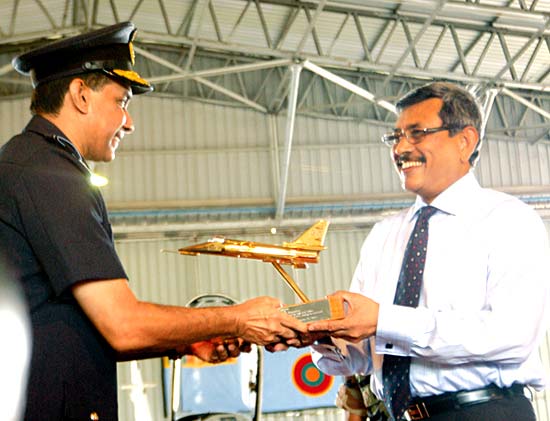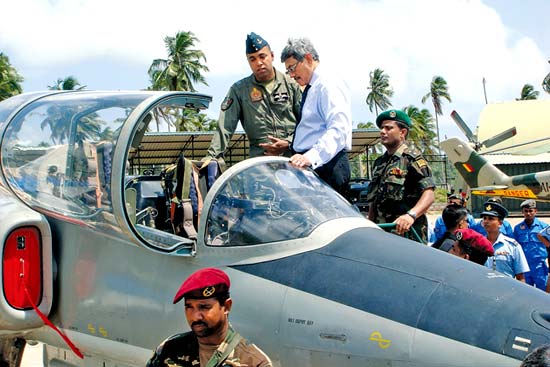SLAF salutes heroes
by Dhaneshi YATAWARA
|

SLAF Commander Air Chief Marshal Roshan Goonetilake presents a
plaque as a token of appreciation to the Defence Secretary.
|
Surely the airmen did wonders in the sky! The complex skills and the
finesse with which they did carry out their missions cannot be achieved
overnight. It takes considerable time and great dedication to create
such human feats. No doubt the importance of suitable aircraft cannot be
underestimated. No wonder our Air Force has become the guardian deity of
our sky.
“Their presence in the battlefront was vital. I know the kind of
anxiety building up in a soldier’s mind if, by chance, the Air Force
fighters get late even half a second. That was the commitment on the
part of the Sri Lanka Air Force and they fulfilled it lavishly,” Defence
Secretary Gotabhaya Rajapaksa said addressing an important gathering
where a cross-section of the entire Sri Lanka Air Force (SLAF) was
present. This was the special event the SLAF held to salute their war
heroes at the Katunayake SLAF base recently.
The Commander of the Air Force, Air Chief Marshal Roshan Goonetilake
firmly believes in working as a team. For him the responsibility of
winning the war against terrorism depended on team spirit. Hence only a
cross section of the entire Air Force was present at the event to
celebrate their victory and to salute the dedication and commitment
displayed by the war heroes risking their precious lives! The gathering
represented every single section of the Air Force including the fighter
squadrons, transport squadrons, engineering, technical, medical and
administration staff, logistics and training etc. The SLAF’s prime
responsibility was to undertake missions to destroy enemy targets.
Hence, their greatest assets are their flying squadrons. From the oldest
flying squadron to the youngest were on a grand display with their
armaments.
The Bell 212 and 412 helicopters of the No. 7 squadron were the pride
of the most experienced flying squadrons in the SLAF. The No. 7 squadron
carried out a wide range of transport movements since the Bell 212s were
added to the SLAF fleet in 1982. Their main missions were ferrying armed
forces personnel, casualty evacuation (CASEVAC) flights, VVIP/VIP
flights and liaison flights. With the two door gunners on either side
the Bell helicopters are capable of landing and carrying out evacuating
missions even amidst enemy fire. The Bell squadron provides the
fundamental training for helicopter pilots of the SLAF.
The giants, AN 32 (popularly known as Antonov) and Hercules C 130
stood grandly representing the No.2 Squadron of the SLAF. This transport
squadron is one of the oldest squadrons. They took the responsibility of
transporting Security Forces personnel to the Northern peninsula at a
time when the entire ground access to Jaffna was cut off by the LTTE. In
addition these “giants” provided transport to Government officials from
other parts of the country who were working in Jaffna. Loads of fresh
food, tons of medical equipment and medicines were also transported
daily in addition to heavy loads of arms and ammunition supplies for the
Security Forces deployed in the North. The AN 32 was in operation since
1995 while the Hercules were commissioned in 2000.
Fighter craft
|

Defence Secretary Gotabhaya Rajapaksa inspects a fighter pilot
training aircraft |
The SLAF is armed to the teeth with attack helicopters as well as
jets. The SLAF effectively used these “warriors” in giving maximum
attrition to the LTTE terrorists. During the humanitarian missions, the
Kfirs - No.10 Squadron carried out the highest number of sorties,
crushing and smashing the enemy targets. Since its advent in 1996 the
Kfirs have proved highly capable of air and ground attack missions and
have supported the Sri Lanka Army and the Navy throughout. They do not
attack blindly; before a Kfir takes off a range of activities take place
in making the target accurate.
The MiG 27s, the No.12 Squadron is the youngest fighter jet squadron
established in 2007. These supersonic fighter bombers are the only air
craft in the SLAF with the variable geometrical wings making them highly
versatile in the skies. They were the proud owners of many victories
during the fourth Eelam war. They were able to demonstrate their
well-knitted skills. They were the real “dare devils” who dealt severe
Blows to the LTTE.
The No.9 squadron with its MI 24s and HIND attack craft were the best
enemy line crushers making direct attack on the enemy defence lines.
Their support to the Army troops in their forward marches was vital as
was proved in many instances in the fourth Eelam war. They would go to
the closest possible point to attack the enemy. Their heavy weapons and
bombs easily crushed the enemy lines effectively. Their support was a
great morale booster to the ground troops. No wonder the MI24s are
called the `battle tank’ of the air.Since its induction in 1993, the MI
17 proved their track record, day and night, facing only minimal threats
from the enemy with their highly professional pilots. Exceeding 5000
flying hours and transporting more than 71 tons of cargo and also
transporting over 6000 injured soldiers, the MI 17 did an outstanding
job in their usual silent manner.
With its unique technical capabilities, MI 17 proved to be the best
in evacuation missions not only during confrontations but in natural
disasters as well.
When part of a forest is threatened with fire, MI17 will be deployed
to douse it, evacuate casualties or transport food, water or medicine
where necessary.
The F7 jets officially known as the No.5 Squadron, has its own
uniqueness - air to air attack capability. They proved their mettle when
the LTTE developed their Air wing and tried to launch attacks on the
southern parts of the country. The F7 GS type air craft were inducted
into the SLAF in 2008. They were the only squadron dedicated to dual
role. A pilot was always on a 24 hours duty shift in a special cubicle
right next to the aircraft.
Such were the exigencies of their service. If the MiGs and Kfirs
needed additional support the F7s were kept ready to meet the situation.
The F7 was a part of the Air Defence System as well. The Air Defence
system was set up in the SLAF when the LTTE started attacking the
commercially and economically important locations in the southern part
of the country.
An air Defence system is compulsory for any country. Established in
2006, the system grew in leaps and bounds experiencing a number of
trials and errors.
The RADAR guided anti air craft guns were most effective in facing
the LTTE threats.
The SLAF unmanned aircraft (UAV) and the beechcraft were the eagle
eyes that observed each and every important movement of the enemy. It
was the most important `information source’ in carrying out the
humanitarian operation. Since their inception in 1983 the beechcraft,
similar to a flying operation room, acted as the eye for the ground
forces. Commanders of the Sri Lanka Army Divisions were constantly
supported by this group watching the ground from staying approximately
15,000 feet high.
It is not just the enemy movements, these two surveillance craft
supplied information on civilians’ movements, their habitats enabling
the Security Forces to avoid attacking civilian lives.
Their operations were atypical. The outside world gets to know only
the result - the damage to the enemy. The hardcore fighters behind the
scene and their stories of bravery hardly come into limelight. What
matters to them is a job well done. And yet they would continue to be
the same!
|

